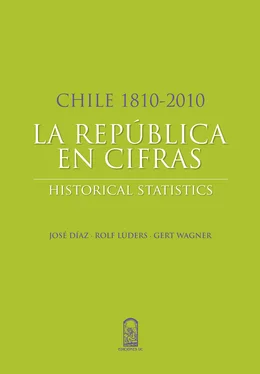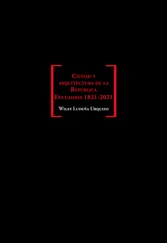All the indicators provide the basis to make substantive descriptions of aggregate development of the country, i.e., the evolution of society and of the people who inhabit its territory. Metaphorically you can imagine this as the record made by a satellite camera, located in a space ship capable of crossing time and drawing footprint captures of the work of Chilean people, finally synthesized into indicators. The contribution of individuals, regions and decentralized entities are added in composite numerical expressions, which incorporate all these contributions as indistinguishable parts of a whole.
Regional and local indicators, as well as references to specific businesses and organizations –except the Treasury– are almost nonexistent, as are names of historical actors, be they generals, ministers, presidents or bishops; actually the only names to be found correspond to authors or to organizations whose data is used in the book to build long-term indicators. However, as the metaphor suggests, aggregate figures contained in these pages take into account everything that happened in a particular time-space area in the country, reflecting, albeit anonymously and inseparably, the work of individual people and organizations, and the expressions of multiple interactions between them.
Without ignoring important contributions of decentralized or private entities, such as for example the Sociedad de Fomento Fabril (SOFOFA) and other similar business associations, the State has been in Chile the major producer of basic statistics. As a result, its capacity and effectiveness to accomplish this task, as well as its willingness to put these statistics at the disposal of the general public, are key ingredients in the construction of the data series presented in this book. At the beginning of the Republic, statistical records were limited to fiscal operations, the movement of foreign trade, and population counts. Around mid-nineteenth century the State created a department in charge of compiling statistics, initially with the idea of improving the quality and coverage of population censuses; then, in the 1860s, it begun to generate statistics of production of a wide range of basic goods and slowly, though with ups and downs, it extended the registration of all types of social phenomena. In the twentieth century another actor emerged in this field, the Central Bank, which undertook the significant task of compiling statistical indicators generated in other departments of Government, as well as to construct its own indicators.
This is not the place to describe the former work, since our knowledge is merely that of users of the basic statistical indicators generated by third parties. But it is pertinent to acknowledge that we found a significant amount of basic statistical material, which we used to construct long data series, illustrating two centuries of evolution of Chilean society. It should, finally, be mentioned, even if only in passing, that some characteristics of the evolutionary process experienced by the country have, in one way or another, complicated the production of basic statistics.
As already noted, in the second half of the nineteenth century the production of basic statistics increased, coinciding with greater fiscal activity in general. But it is not until First World War and the 1920s that the State experienced a significant change in its sphere of influence, notably increasing its presence, imposing new regulations and public activities. The process continues until the present and especially during the first half of the 20th century, the greater participation of the state in the economy was not always accompanied by a parallel growth in its capacity to gather statistical material in order to achieve adequate coverage.
Another aspect that complicates the production of basic statistics is that since the 1930s the Treasury, and therefore the country, did not always distinguish between accounts in nominal and real values. This distinction became only clear again in the late twentieth century.
Throughout the two centuries starting in 1810 the country underwent changes and transformations of various kinds, keeping fundamental traits that evolved only slowly. Therefore, to finish this compilation in 2010 seems an appropriate time, not only because it is an important anniversary, the end of two centuries since Independence, but also because from then on much of the series can easily be updated by those who require such records. Once you have obtained some of the patience of a good navigator, it will be possible to make contact with the pages and publications of the agencies that produce statistics, thus incorporating indicators for subsequent years. This notwithstanding the fact that this is a dynamic context, surely evolving, so that the possibility of changes and innovations in the presentation of figures by producers of basic statistics may require some additional effort to achieve continuity with the indicators included in this publication.
At the other end, the starting of the compilation in 1810 is a more complex choice, but as we hope to show, not entirely arbitrary. Starting date coincides with today’s view, symbolically at least, that it is the beginning of the process that eventually culminated in the Republic of Chile. Although in many important aspects the new organizational form maintained previous institutions, there is good reason to believe that 1810 marks a significant break with regard to the construction of indicators to describe the country’s development capacity. Conflicts, expropriations and other phenomena implicit in the change of power from a colonial structure towards that of a republican organization, translated into difficulties and adjustments for production in the territory, in addition to fiscal financing limitations that often accompany transitions such as the one mentioned. Moreover, the explicit and formal trade liberalization adopted early as well as the tax base that is associated to it, probably drove changes and generated various stimuli, opening new opportunities and, as it is worth mentioning here, new challenges in construction of basic statistics.
Authors have estimated that the adjustment process associated with the full independence cycle, expressed in terms of production, took approximately 20 years and according to their best guess in the early 1830s the country regained per capita income of 1810 (Díaz, Lüders and Wagner 2007). This, then, is a second argument for our starting date: 1810 corresponds to the last year before the beginning of an extensive process of economic and socio-political changes of all kinds that are associated with new statistical challenges. A third argument in favor of using 1810 as the starting date of the compilation is related to the availability of basic material for setting such indicators.
A corollary of the previous discussion is that the definition of a starting date is convenient, while recognizing that the arguments given do not point strictly to 1810. However they emphasize that in this general context, around 1810 there seems to be a need to innovate in the search for basic data for the construction of development series. Finally, the choice of starting date does not mean that all series begin with 1810 –rather few of them actually do– and in this sense the starting year is simply a reference.
Series listed in this volume correspond to homogeneous indicators constructed by authors on the basis of background information gathered for this purpose. The following paragraphs briefly explain, first, why the series are identified as constructions and then, why homogeneity and continuity was sought. Very few of these series correspond to what might be called simple transfers, i.e. copying existing series from their sources. This is so in spite of several important intertemporal consolidation efforts which can be found in some of the work of official statistical agencies and some other sources.
Читать дальше












